
|
Now it is bright as 8.3 mag (July 8, Chris Wyatt). It stays bright as 8-9 mag for a while. In the Southern Hemisphere, it stays observable in good condition for a long time until the comet will fade out. In the Northern Hemisphere, it will be unobservable soon.
Date(TT) R.A. (2000) Decl. Delta r Elong. m1 Best Time(A, h)
July 7 17 10.88 -49 44.3 1.335 2.245 145 8.4 22:07 ( 0, 5)
July 14 16 37.27 -52 38.2 1.398 2.233 134 8.5 21:07 ( 0, 2)
|
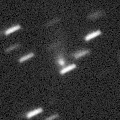
|
Now it is very bright as 8.8 mag (June 23, Chris Wyatt). In the Southern Hemisphere, it is observable from July to September, but it locates in extremely low. In the Northern Hemisphere, it is not observable until late December.
Date(TT) R.A. (2000) Decl. Delta r Elong. m1 Best Time(A, h)
July 7 5 42.91 1 0.2 1.587 0.857 29 9.3 3:07 (255,-19)
July 14 6 15.32 -4 43.1 1.485 0.831 32 9.1 3:13 (260,-22)
|
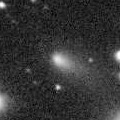
|
Now it is very bright as 10.3 mag (July 9, Juan Jose Gonzalez). It will brighten rapidly, and brighten up to 7 mag from August to September. In the Northern Hemisphere, it will be observable in excellent condition. In the Southern Hemisphere, it will be unobservable from July to August. But it will be observable in good condition before and after that.
Date(TT) R.A. (2000) Decl. Delta r Elong. m1 Best Time(A, h)
July 7 21 45.84 53 33.6 0.796 1.356 96 10.7 2:47 (180, 72)
July 14 22 10.60 57 27.0 0.737 1.298 94 10.1 2:43 (180, 68)
|
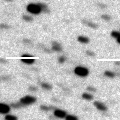
|
It brightened rapidly. Now it is very bright as 9.1 mag (July 7, Carlos Labordena). It is expected to approach to Sun down to 0.2 a.u. and brighten up to 3 mag in August. In the Northern Hemisphere, it stays observable in the morning sky until early August when the comet brightens up to 6 mag. It is not observable at all in the Southern Hemisphere.
Date(TT) R.A. (2000) Decl. Delta r Elong. m1 Best Time(A, h)
July 7 3 34.47 59 3.0 1.410 1.115 51 11.2 3:07 (217, 33)
July 14 4 20.06 57 39.9 1.230 0.965 49 10.3 3:13 (219, 32)
|
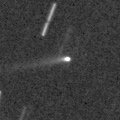
|
It brightened rapidly as predicted. Now it is very bright as 11.0 mag (July 8, Chris Wyatt). In the Southern Hemisphere, it stays observable in good condition all through this apparition. In the Northern Hemisphere, it is not observable at the high light from mid June to mid August.
Date(TT) R.A. (2000) Decl. Delta r Elong. m1 Best Time(A, h)
July 7 7 48.68 -12 30.0 0.259 0.824 36 10.7 21:02 ( 99,-36)
July 14 7 1.31 -21 10.9 0.239 0.859 43 10.9 3:13 (268,-41)
|

|
Bright new comet. Now it is 11.2 mag (July 9, Michael Mattiazzo). It approaches to Earth down to 0.3 a.u. in late July, and it will move very fast in the southern sky. It stays observable in good condition until September. It locates somewhat low in the Northern Hemisphere.
Date(TT) R.A. (2000) Decl. Delta r Elong. m1 Best Time(A, h)
July 7 0 58.09 -11 47.7 0.815 1.365 95 11.9 3:07 (310, 28)
July 14 0 27.57 -17 1.0 0.582 1.339 110 11.1 3:13 (328, 32)
|
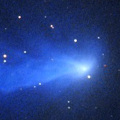
|
Now it is 11.3 mag (July 9, Juan Jose Gonzalez). It stays bright as 11 mag for a long time until autumn. In the Southern Hemisphere, it is not observable for a long time after this. In the Northern Hemispehre, it stays observable for a long time until the comet fades out. But it stays very low until autumn.
Date(TT) R.A. (2000) Decl. Delta r Elong. m1 Best Time(A, h)
July 7 8 2.25 52 13.7 3.487 2.675 31 11.3 21:02 (147, 12)
July 14 8 23.89 52 31.9 3.496 2.693 32 11.4 20:57 (147, 12)
|

|
Now it is 11.7 mag (June 12, Juan Jose Gonzalez). It stays 12 mag for a long time until spring in 2019. In the Northern Hemisphere, it stays observable in good condition for a long time, although it becomes unobservable temporarily from mid June to August. In the Southern Hemisphere, it is not observable until September.
Date(TT) R.A. (2000) Decl. Delta r Elong. m1 Best Time(A, h)
July 7 8 19.44 34 39.6 3.600 2.672 20 12.3 21:02 (132, 2)
July 14 8 24.07 32 41.8 3.633 2.669 15 12.3 20:57 (133, -2)
|
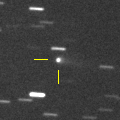
|
Now it is 13.9 mag (June 21, Kunihiro Shima). It is expected to brighten up to 12-13 mag from summer to autumn. It is observable in excellent condition in the Southern Hemisphere. It locates somewhat low in the Northern Hemisphere. Juan Jose Gonzalez reported it was very bright as 11.5 mag on June 19.
Date(TT) R.A. (2000) Decl. Delta r Elong. m1 Best Time(A, h)
July 7 22 33.80 -17 6.9 1.212 2.025 130 13.1 3:07 (351, 38)
July 14 22 38.30 -18 5.3 1.157 2.018 136 13.0 3:12 ( 0, 37)
|

|
Now it is 15.7 mag (June 21, Kunihiro Shima).
Date(TT) R.A. (2000) Decl. Delta r Elong. m1 Best Time(A, h)
July 7 23 20.68 1 18.6 5.304 5.778 113 13.3 3:07 (328, 52)
July 14 23 20.29 1 27.5 5.206 5.777 119 13.3 3:13 (342, 55)
|
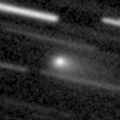
|
Now it is bright as 12.1 mag (June 23, Chris Wyatt). It will be observable at 12-13 mag in good condition from spring to summer. Juan Jose Gonzalez reported it was very bright as 10.5 mag on June 13.
Date(TT) R.A. (2000) Decl. Delta r Elong. m1 Best Time(A, h)
July 7 23 36.99 -0 47.0 1.089 1.728 110 13.3 3:07 (324, 48)
July 14 23 41.57 0 46.7 1.060 1.753 115 13.4 3:13 (333, 53)
|
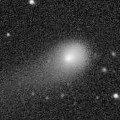
|
Now it is 13.3 mag (July 8, Gabor Santa). It will be observable at 12-13 mag for a long time from 2017 to 2018. In the Southern Hemisphere, it will be hardly observable after this.
Date(TT) R.A. (2000) Decl. Delta r Elong. m1 Best Time(A, h)
July 7 11 49.23 46 42.1 4.312 3.925 61 13.7 21:02 (124, 42)
July 14 11 46.46 45 20.6 4.416 3.945 56 13.8 20:57 (124, 37)
|
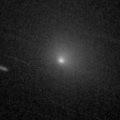
|
It brightened rapidly, and brightened up to 10.2 mag from May to June (May 22, Chris Wyatt). Now it is fading. But it is still bright as 12.7 mag (July 9, Chris Wyatt).In the Southern Hemisphere, it stays observable in excellent condition. It will be getting higher gradually after this also in the Northern Hemisphere.
Date(TT) R.A. (2000) Decl. Delta r Elong. m1 Best Time(A, h)
July 7 1 12.09 -20 54.0 0.924 1.444 96 14.1 3:07 (314, 19)
July 14 1 19.37 -19 29.3 0.924 1.486 99 15.1 3:13 (318, 24)
|

|
Now it is 19.2 mag (June 13, Toshihiko Ikemura, Hirohisa Sato). It will brighten rapidly, and it is expected to brighten up to 10 mag in autumn. But actually, it is much fainter than this ephemeris. It will be observable in excellent condition in the Northern Hemisphere. It stays low in the Southern Hemisphere.
Date(TT) R.A. (2000) Decl. Delta r Elong. m1 Best Time(A, h)
July 7 23 25.00 2 2.0 1.338 1.958 111 14.5 3:07 (326, 52)
July 14 23 33.37 3 56.9 1.232 1.906 115 14.2 3:13 (335, 57)
|
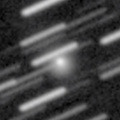
|
Now it is 13.5 mag (July 8, Gabor Santa). It stays 13-14 mag until summer in 2019. In the Northern Hemisphere, it stays observable in good condition for a while. In the Southern Hemisphere, it locates extremely low until summer.
Date(TT) R.A. (2000) Decl. Delta r Elong. m1 Best Time(A, h)
July 7 17 22.69 41 48.1 3.243 3.737 111 14.3 22:20 (180, 83)
July 14 17 9.55 39 46.5 3.231 3.706 110 14.2 21:39 (180, 85)
|
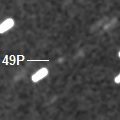
|
The condition is worst in this apparition. It brightens up to 14.5 mag from June to August, but it is not observable at all.
Date(TT) R.A. (2000) Decl. Delta r Elong. m1 Best Time(A, h)
July 7 6 18.12 17 15.6 2.412 1.433 11 14.7 3:07 (236,-15)
July 14 6 41.91 17 48.9 2.406 1.430 12 14.6 3:13 (237,-13)
|

|
Now it is 15.2 mag (June 21, Kunihiro Shima). It will brighten rapidly after this, and it is expected to brighten up to 9 mag from autumn to winter. In the Northern Hemisphere, it will be getting higher gradually after July. Then it stays observable in good condition for a long time until it fades out. In the Southern Hemispehre, it is observable in good condition until autumn, but it will be low in winter.
Date(TT) R.A. (2000) Decl. Delta r Elong. m1 Best Time(A, h)
July 7 2 41.31 -0 47.4 2.389 2.215 67 15.0 3:07 (283, 17)
July 14 2 55.39 0 15.2 2.274 2.160 70 14.6 3:13 (285, 21)
|

|
Now it is 15.1 mag (June 18, Martin Masek). It stays 15 mag from 2018 to 2019, and it will be observable for a long time in the Southern Hemisphere. In the Northern Hemisphere, it will never be observable again.
Date(TT) R.A. (2000) Decl. Delta r Elong. m1 Best Time(A, h)
July 7 12 2.15 -64 44.6 3.959 4.321 104 15.0 21:02 ( 23,-20)
July 14 12 6.31 -64 26.6 3.987 4.296 100 15.0 20:57 ( 25,-22)
|

|
Now it is 17.5 mag (June 18, Martin Masek). It is observable at 15 mag in 2018, in good condition in the Southern Hemisphere. It locates somewhat low in the Northern Hemisphere.
Date(TT) R.A. (2000) Decl. Delta r Elong. m1 Best Time(A, h)
July 7 23 30.98 -15 27.1 2.589 3.181 116 15.4 3:07 (334, 36)
July 14 23 32.01 -15 44.1 2.522 3.194 123 15.4 3:13 (344, 38)
|

|
It brightened up to 7.1 mag from May to June in 2017 (June 21, Juan Jose Gonzalez). Now it is fading. It has already faded down to 15.2 mag (June 18, Martin Masek). In the Southern Hemisphere, it stays observable for a long time after this. It will never be observable again in the Northern Hemisphere.
Date(TT) R.A. (2000) Decl. Delta r Elong. m1 Best Time(A, h)
July 7 2 2.30 -46 5.2 4.545 4.769 96 15.4 3:07 (323, -7)
July 14 2 5.46 -46 51.8 4.547 4.833 100 15.4 3:13 (327, -4)
|

|
Now it is 14.7 mag (June 22, Toshihiko Ikemura, Hirohisa Sato). It stays at 14-15 mag for a long time from summer to winter. In the Southern Hemisphere, it stays observable in excellent condition for a while. But it will be getting lower rapidly in September, then it becomes unobservable after October. In the Northern Hemisphere, it stays observable for a long time until it fades out. But it stays extremely low.
Date(TT) R.A. (2000) Decl. Delta r Elong. m1 Best Time(A, h)
July 7 13 48.17 -27 56.2 2.008 2.539 109 15.6 21:02 ( 31, 20)
July 14 13 50.66 -24 59.3 2.044 2.479 103 15.5 20:57 ( 37, 20)
|

|
It will brighten up to 14 mag in winter. It will be observable in excellent condition in the Northern Hemisphere. In the Southern Hemisphere, it is observable only until August.
Date(TT) R.A. (2000) Decl. Delta r Elong. m1 Best Time(A, h)
July 7 3 4.69 22 48.5 2.664 2.235 54 15.7 3:07 (259, 25)
July 14 3 16.52 25 12.0 2.563 2.203 58 15.7 3:13 (259, 30)
|
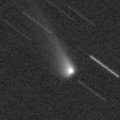
|
Now it is 17.2 mag (May 19, CAO, San Pedro de Atacama). Fading now. It stays observable in good condition for a long time after this in the Southern Hemisphere. It stays low in the Northern Hemisphere.
Date(TT) R.A. (2000) Decl. Delta r Elong. m1 Best Time(A, h)
July 7 0 58.41 -15 39.5 4.343 4.581 97 15.8 3:07 (313, 25)
July 14 0 56.20 -17 14.0 4.243 4.602 104 15.8 3:13 (322, 29)
|
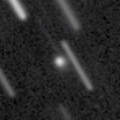
|
It brightened rapidly. Now it is 15.5 mag (June 12, Toshihiko Ikemura, Hirohisa Sato). It will be fading after this, and will be fainter than 18 mag in August.
Date(TT) R.A. (2000) Decl. Delta r Elong. m1 Best Time(A, h)
July 7 14 52.33 7 24.7 1.390 2.003 111 16.3 21:02 ( 34, 58)
July 14 14 57.65 3 25.3 1.456 2.023 108 16.5 20:57 ( 38, 52)
|

|
Now it is 16.2 mag (June 17, Jean-Francois Soulier). It stays 16 mag for a while. In the Southern Hemisphere, it stays observable until August, but it will be unobservable after that. In the Northern Hemisphere, it becomes observable in good condition after this. Its cometary activity was observed on Mar. 26 (M. Mommert, D. Polishook, N. Moskovitz).
Date(TT) R.A. (2000) Decl. Delta r Elong. m1 Best Time(A, h)
July 7 2 11.11 16 51.3 1.487 1.459 68 16.3 3:07 (272, 33)
July 14 2 21.68 20 23.6 1.478 1.506 71 16.3 3:13 (271, 39)
|
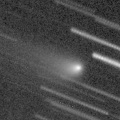
|
It is fading now, but it stays 16 mag until summer. But actually, it is 18.1 mag (Mar. 23, Toshihiko Ikemura, Hirohisa Sato), fainter than this ephemeris.
Date(TT) R.A. (2000) Decl. Delta r Elong. m1 Best Time(A, h)
July 7 16 13.23 -27 24.0 3.296 4.139 141 16.4 21:11 ( 0, 28)
July 14 16 2.36 -27 1.4 3.436 4.188 132 16.5 20:57 ( 6, 28)
|
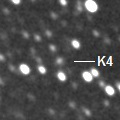
|
Now it is 17.2 mag (May 21, Toshihiko Ikemura, Hirohisa Sato). It was observed at 16 mag from summer to autumn in 2017. It will be observable at 16.5 mag in good condition also in 2018. It locates somewhat low in the Southern Hemisphere.
Date(TT) R.A. (2000) Decl. Delta r Elong. m1 Best Time(A, h)
July 7 0 57.40 22 42.2 3.153 3.189 82 16.5 3:07 (276, 51)
July 14 1 2.01 23 51.6 3.102 3.226 87 16.5 3:13 (280, 57)
|
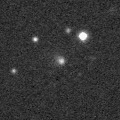
|
Unexpectedly, it brightened rapidly. Now it is 16.6 mag (May 15, Toshihiko Ikemura, Hirohisa Sato). It stays at 16.5 mag until July.
Date(TT) R.A. (2000) Decl. Delta r Elong. m1 Best Time(A, h)
July 7 13 4.94 -0 42.3 1.782 2.062 90 16.6 21:02 ( 59, 35)
July 14 13 15.15 -1 33.0 1.846 2.055 86 16.7 20:57 ( 61, 32)
|

|
It brightened up to 14.8 mag in May (May 26, Ken-ichi Kadota). It stays observable in good condition for a while. But it will fade out rapidly after this. It has already faded down to 17.5 mag (June 21, Kunihiro Shima). It will be fainter than 18 mag in August.
Date(TT) R.A. (2000) Decl. Delta r Elong. m1 Best Time(A, h)
July 7 15 8.62 -13 50.0 1.435 2.173 123 16.7 21:02 ( 18, 39)
July 14 14 49.97 -11 48.9 1.620 2.215 112 17.0 20:57 ( 31, 38)
|
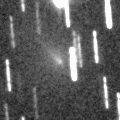
|
Now it is 17.2 mag (June 21, Kunihiro Shima). It is observable in good condition after this in the Southern Hemisphere. But it stays low in the Northern Hemisphere.
Date(TT) R.A. (2000) Decl. Delta r Elong. m1 Best Time(A, h)
July 7 19 46.42 -41 14.8 1.337 2.316 159 16.8 0:51 ( 0, 14)
July 14 19 2.64 -43 35.9 1.411 2.381 157 17.0 23:30 ( 0, 11)
|

|
Now it is 16.5 mag (June 17, Martin Masek). It will be fading slowly until summer.
Date(TT) R.A. (2000) Decl. Delta r Elong. m1 Best Time(A, h)
July 7 11 47.97 7 36.3 3.805 3.581 69 16.9 21:02 ( 81, 26)
July 14 11 53.87 6 46.2 3.899 3.585 64 16.9 20:57 ( 83, 22)
|
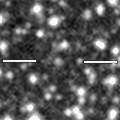
|
Now it is 17.9 mag (June 13, Toshihiko Ikemura, Hirohisa Sato). It stays observable at 17 mag in good condition from spring to autumn.
Date(TT) R.A. (2000) Decl. Delta r Elong. m1 Best Time(A, h)
July 7 20 59.29 2 9.5 5.156 5.994 142 17.0 2:01 ( 0, 57)
July 14 20 57.66 2 12.1 5.109 5.996 148 17.0 1:32 ( 0, 57)
|
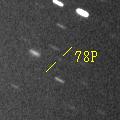
|
Now it is 17.2 mag (June 13, Toshihiko Ikemura, Hirohisa Sato). It stays at 13 mag for a long time from winter to autumn in 2019. It stays observable in good condition until winter when the comet brightens up to 13 mag.
Date(TT) R.A. (2000) Decl. Delta r Elong. m1 Best Time(A, h)
July 7 22 3.85 -3 3.3 2.082 2.865 132 17.3 3:06 ( 0, 52)
July 14 22 2.75 -2 54.5 1.987 2.833 138 17.0 2:37 ( 0, 52)
|

|
Now it is 17.1 mag (June 13, Toshihiko Ikemura, Hirohisa Sato). It will be fading gradually after this, and it will be fainter than 18 mag in winter. In the Northern Hemisphere, it stays observable in good condition for a long time. In the Southern Hemisphere, it will never be observable again.
Date(TT) R.A. (2000) Decl. Delta r Elong. m1 Best Time(A, h)
July 7 23 47.70 74 55.8 7.589 7.355 72 17.0 3:07 (190, 48)
July 14 23 49.09 75 32.8 7.576 7.379 75 17.1 3:13 (187, 49)
|
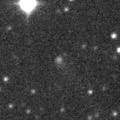
|
Now it is 16.9 mag (May 15, Toshihiko Ikemura, Hirohisa Sato). It will be fainter than 18 mag in summer.
Date(TT) R.A. (2000) Decl. Delta r Elong. m1 Best Time(A, h)
July 7 14 26.77 -3 53.1 6.124 6.553 110 17.1 21:02 ( 35, 45)
July 14 14 26.78 -3 29.8 6.254 6.574 104 17.2 20:57 ( 42, 42)
|

|
Now it is 17.2 mag (July 1, E. J. Christensen). It stays 17 mag until August. It is observable in good condition in the Northern Hemisphere. It will be getting low and becom unobservable soon in the Southern Hemisphere.
Date(TT) R.A. (2000) Decl. Delta r Elong. m1 Best Time(A, h)
July 7 2 3.35 20 5.0 1.273 1.316 69 17.2 3:07 (270, 36)
July 14 2 21.91 26 0.7 1.255 1.317 69 17.2 3:13 (265, 42)
|
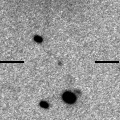
|
It is expected to brighten up to 7-8 mag in 2020. It is already observable in good condition in the Southern Hemisphere. It will become observable in good condition also in the Northern Hemisphere.
Date(TT) R.A. (2000) Decl. Delta r Elong. m1 Best Time(A, h)
July 7 3 48.39 -3 44.9 7.683 7.139 54 17.5 3:07 (275, 1)
July 14 3 51.20 -3 39.7 7.542 7.083 59 17.4 3:13 (280, 8)
|
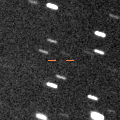
|
Now it is 18.1 mag (June 13, Toshihiko Ikemura, Hirohisa Sato). It will be observable at 16.5 mag in good condition from August to September.
Date(TT) R.A. (2000) Decl. Delta r Elong. m1 Best Time(A, h)
July 7 21 51.22 -5 15.7 1.570 2.407 135 17.8 2:53 ( 0, 50)
July 14 21 51.24 -4 52.5 1.485 2.372 142 17.6 2:26 ( 0, 50)
|

|
Now it is 19.6 mag (June 15, Hidetaka Sato). It is predicted to be observable at 17 mag in good condition in autumn. But actually, it is fainter than this ephemeris by 1 mag.
Date(TT) R.A. (2000) Decl. Delta r Elong. m1 Best Time(A, h)
July 7 1 28.33 0 39.1 2.367 2.476 83 17.9 3:07 (295, 32)
July 14 1 37.11 1 13.0 2.281 2.471 88 17.8 3:13 (299, 37)
|
|
![]()
 C/2016 R2 ( PanSTARRS )
C/2016 R2 ( PanSTARRS ) C/2016 N6 ( PanSTARRS )
C/2016 N6 ( PanSTARRS ) 48P/Johnson
48P/Johnson 29P/Schwassmann-Wachmann 1
29P/Schwassmann-Wachmann 1 37P/Forbes
37P/Forbes C/2015 O1 ( PanSTARRS )
C/2015 O1 ( PanSTARRS ) 66P/du Toit
66P/du Toit 64P/Swift-Gehrels
64P/Swift-Gehrels C/2017 M4 ( ATLAS )
C/2017 M4 ( ATLAS ) 49P/Arend-Rigaux
49P/Arend-Rigaux 38P/Stephan-Oterma
38P/Stephan-Oterma C/2017 B3 ( LINEAR )
C/2017 B3 ( LINEAR ) 65P/Gunn
65P/Gunn C/2015 V2 ( Johnson )
C/2015 V2 ( Johnson ) C/2018 L2 ( ATLAS )
C/2018 L2 ( ATLAS ) (944) Hidalgo
(944) Hidalgo C/2015 V1 ( PanSTARRS )
C/2015 V1 ( PanSTARRS ) C/2018 C2 ( Lemmon )
C/2018 C2 ( Lemmon ) (3552) Don Quixote
(3552) Don Quixote C/2015 VL62 ( Lemmon-Yeung-PanSTARRS )
C/2015 VL62 ( Lemmon-Yeung-PanSTARRS ) C/2017 K4 ( ATLAS )
C/2017 K4 ( ATLAS ) 105P/Singer Brewster
105P/Singer Brewster C/2018 K1 ( Weiland )
C/2018 K1 ( Weiland ) C/2017 S6 ( Catalina )
C/2017 S6 ( Catalina ) 74P/Smirnova-Chernykh
74P/Smirnova-Chernykh C/2017 M5 ( TOTAS )
C/2017 M5 ( TOTAS ) 78P/Gehrels 2
78P/Gehrels 2 C/2014 OE4 ( PanSTARRS )
C/2014 OE4 ( PanSTARRS ) C/2017 E3 ( PanSTARRS )
C/2017 E3 ( PanSTARRS ) C/2018 M1 ( Catalina )
C/2018 M1 ( Catalina ) C/2017 T2 ( PanSTARRS )
C/2017 T2 ( PanSTARRS ) 137P/Shoemaker-Levy 2
137P/Shoemaker-Levy 2 243P/NEAT
243P/NEAT![]()





























